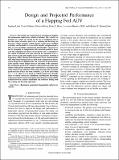Design and Projected Performance of a Flapping Foil AUV
Author(s)
Licht, Stephen; Polidoro, Victor; Flores, Melissa; Hover, Franz S.; Triantafyllou, Michael S.
DownloadTriantafyllou-2004-Design.pdf (928.3Kb)
Terms of use
Metadata
Show full item recordAbstract
The design and construction of a biomimetic flapping
foil autonomous underwater vehicle is detailed. The vehicle was
designed as a proof of concept for the use of oscillating foils as
the sole source of motive power for a cruising and hovering underwater
vehicle. Primary vehicle design requirements included
scalability and flexibility in terms of the number and placement of
foils, so as to maximize experimental functionality. This goal was
met by designing an independent self-contained module to house
each foil, requiring only direct current power and a connection to
the vehicle’s Ethernet local area network for operation. The results
of tests on the foil modules in the Massachusetts Institute of
Technology (MIT) Marine Hydrodynamics Water Tunnel and the
MIT Ship Model Testing Tank are both used to demonstrate fundamental
properties of flapping foils and to predict the performance
of the specific vehicle design based on the limits of the actuators.
The maximum speed of the vehicle is estimated based on the limitations
of the specific actuator and is shown to be a strong function
of the vehicle drag coefficient. When using four foils, the maximum
speed increases from 1 m/s with a vehicle Cd of 1.4 to 2 m/s when
Cd = 0.1, where Cd is based on vehicle frontal area. Finally,
issues of vehicle control are considered, including the decoupling
of speed and pitch control using pitch-biased maneuvering and the
tradeoff between actuator bandwidth and authority during both
the cruising and hovering operation.
Date issued
2004-07Department
Massachusetts Institute of Technology. Department of Mechanical EngineeringPublisher
Institute of Electrical and Electronic Engineers
Citation
IEEE Journal of Oceanic Engineering, 29 (3), p.786-794 (2004)
Keywords
Biomimetic propulsion, flapping foils, underwater propulsion